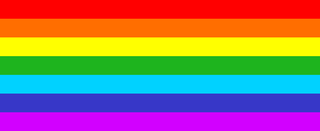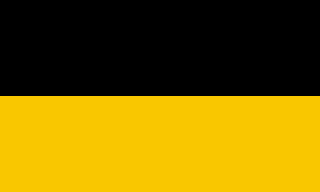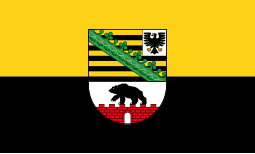The House of Ascania was a dynasty of German rulers. It is also known as the House of Anhalt, which refers to its longest-held possession, Anhalt.

Yellow is the color between green and orange on the spectrum of light. It is evoked by light with a dominant wavelength of roughly 575–585 nm. It is a primary color in subtractive color systems, used in painting or color printing. In the RGB color model, used to create colors on television and computer screens, yellow is a secondary color made by combining red and green at equal intensity. Carotenoids give the characteristic yellow color to autumn leaves, corn, canaries, daffodils, and lemons, as well as egg yolks, buttercups, and bananas. They absorb light energy and protect plants from photo damage in some cases. Sunlight has a slight yellowish hue when the Sun is near the horizon, due to atmospheric scattering of shorter wavelengths.

Saxony-Anhalt is a state of Germany, bordering the states of Brandenburg, Saxony, Thuringia and Lower Saxony. It covers an area of 20,451.7 square kilometres (7,896.4 sq mi) and has a population of 2.17 million inhabitants, making it the 8th-largest state in Germany by area and the 11th-largest by population. Its capital is Magdeburg and its largest city is Halle (Saale).

A rainbow flag is a multicolored flag consisting of the colors of the rainbow. The designs differ, but many of the colors are based on the seven spectral colors of the visible light spectrum.

The national flag of Belgium is a tricolour consisting of three equal vertical bands displaying the national colours of Belgium: black, yellow, and red. The colours were taken from the coat of arms of the Duchy of Brabant, and the vertical design may be based on the flag of France. When flown, the black band is nearest the pole. It has the unusual proportions of 13∶15.
Color or colour is the visual perceptual property corresponding in humans to the categories called red, yellow, blue, green, etc.

Gold, also called golden, is a color tone resembling the gold chemical element.

The flag of Serbia, also known as the Tricolour, is a tricolour consisting of three equal horizontal bands, red on the top, blue in the middle, and white on the bottom. The same tricolour, in altering variations, has been used since the 19th century as the flag of the state of Serbia and the Serbian nation. The current form of the flag was adopted in 2004 and slightly redesigned in 2010.

The flag of Bolivia is the national flag of the Plurinational State of Bolivia. It was originally adopted in 1851. The state and war flag is a horizontal tricolor of red, yellow and green with the Bolivian coat of arms in the center. According to one source, the red stands for Bolivia's brave soldiers, while the green symbolizes fertility and yellow the nation's mineral deposits.

The flag of Bosnia and Herzegovina contains a medium blue field with a yellow right triangle separating said field, and there are seven full five-pointed white stars and two half stars top and bottom along the hypotenuse of the triangle.

Jamaica coalition is a term in German politics describing a governing coalition among the parties of the Christian Democratic Union/Christian Social Union (CDU/CSU), Free Democratic Party (FDP), and the Green Party.

The coat of arms of the present-day German free state of Saxony shows a tenfold horizontally-partitioned field of black (sable) and gold/yellow (or) stripes, charged with a green (vert) crancelin running from the viewer's top-left to bottom-right. Although the crancelin is sometimes shown bent (embowed) like a crown, this is due to artistic license. The coat of arms is also displayed on the state flag of Saxony.

Chinese culture attaches certain values to colours, like which colours are considered auspicious (吉利) or inauspicious (不利). The Chinese word for "colour" is yánsè (顏色). In Classical Chinese, the character sè (色) more accurately meant "colour in the face", or "emotion". It was generally used alone and often implied sexual desire or desirability. During the Tang Dynasty, the word yánsè came to mean 'all colour'. A Chinese idiom with the meaning “many colours” or “multi-coloured”, Wǔyánliùsè (五顏六色), can also mean 'colours' in general.

The flag of Baden-Württemberg, a state in Germany, has three variants. The civil flag has one design, while the state flag, has two designs. All three flags are a black over gold bi-color, while the state flag has one of two variants of the state arms centered on the flag. The flag, while identical, has no symbolism of or relation with the flag of the Austrian Empire.

The flag of Brandenburg is a horizontal bi-color of red over white, with the arms of the state (land), in the center. The coat of arms of the state shows on a shield in white (silver) a red eagle, looking to the right, with wings decorated with trefoils in gold and armored gold. In its current form, the flag was adopted on 30 January 1991, with further enshrinement in Article 4 of the Constitution of the State of Brandenburg.

A Naturschutzgebiet is a category of protected area within Germany's Federal Nature Conservation Act . Although often translated as 'Nature Reserve' in English, the Federal Agency for Nature Conservation (BfN) refers to them as 'Nature Conservation Areas'. It meets the criteria of an IUCN Category IV Habitat and Species Management Area.

The Order of Merit of Saxony-Anhalt is the highest award of the German State of Saxony-Anhalt. Established 23 May 2006, the order is presented by the Minister-President of Saxony-Anhalt. The total number of living recipients is limited to 300. Recipients of the order are recognized for exceptional performance over a longer period of time or an extraordinary individual performance for Saxony-Anhalt and its citizens. Individuals are considered from among the citizens and non-citizens of Saxony-Anhalt.

The Black-red-green coalition, also known as the Kenya coalition is a term in German politics describing a governing coalition among the parties of the Christian Democratic Union (CDU), Social Democratic Party (SPD) and the Green Party. The name comes from the traditional colours of the parties, with the CDU represented by black, the SPD by red, and the Greens by green. As these are also the colours of the Kenyan and Afghan flags, the names of these countries are sometimes applied to the arrangement, in the same manner as the black-yellow-green "Jamaica coalition".
In Germany's federal electoral system, a single party or parliamentary group rarely wins an absolute majority of seats in the Bundestag, and thus coalition governments, rather than majority governments, are the usually expected outcome of a German election. As German political parties are often associated with particular colors, coalitions are frequently given nicknames based on the colors included. Prominent political parties in Germany are the CDU/CSU (black), the SPD (red), the Greens (green), the Left, the AfD (blue), and the FDP (yellow).



















